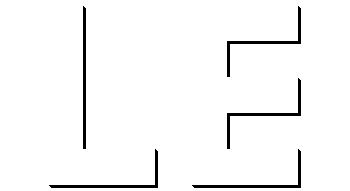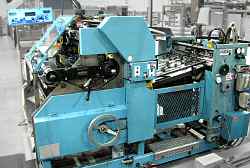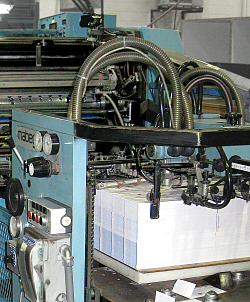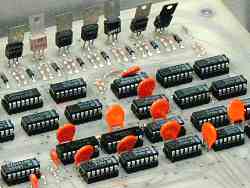LAUGHTON ELECTRONICS |
|
The Microchek Press: a specialized unit from Heath Custom Press |
|
 |
This article describes a moderately challenging class of printing presses I used to service, beginning with buggy, early-issue machines which were essentially manufacturer's prototypes. I also modified some of the machines' behavior in order to better meet the production requirements of the customer. |
|
To call this machine a printing press would only tell half the story. It is really two machines in one, specially built to print cheques for use by consumers and business. A key requirement with cheque printing is the sequential cheque number that appears on every sheet. The sequential number is different for each individual sheet (although of course other information such as the name and address stays the same throughout a run). The Microchek press prints the customer information using a lithographic master, and prints the sequential numbers using odometer-like ratcheting numbering machines — all in a single operation. Pneumatic cylinders are used for actuating the various mechanisms, and the cylinders are electronically controlled by an array of 24 volt air solenoids. The original MicroChek wiring used a logic board with about thirty 74C00 series CMOS chips. Timing signals originated from four optical switches reading timing disks mounted on the driveshaft. On the logic box, two sets of thumbwheel switches were used to determine how many cheques and how many (un-numbered) deposit sheets would be in each run. The numbering options and operating sequences were hardwired, albeit with a degree of control via a big 6-Pole, 12-position rotary Mode Switch. Repairs and ModificationsThese presses were subject to predictable problems such as contamination of the optical sensors and occasional shorts or bad connections where the press wiring was subject to mechanical wear and tear. Early production presses also had some design issues yet to be sorted out, especially with regard to spurious operation of the logic. Regarding this class of problems we were advised at one point to drill a hole in the concrete floor next to every press and to install the biggest ground rod we could find! I guess it's remotely possible that might've improved the situation somewhat, but instead I eradicated the problem by making wiring changes to ensure the 12 volt supplies for the logic boxes were properly regulated, and by adding noise filtering in the form of a simple RC wherever "outside world" signals such as the timing disks were brought into the logic box. Over the years I was repeatedly asked to make changes to the logic, simply because the customer's needs weren't always accommodated by the existing sequences. Changes usually involved poring over the schematics for a while, then tapping in to the logic board and wiring in an extra gate, flip-flop or two. Although I would always oblige the customer, I was never very keen on making those sorts of changes. To me it was blatantly obvious that a microprocessor ought to replace the inflexible hard-wired logic. A decade or so later my view was vindicated when Heath Custom Press discontinued the old style logic box and began supplying microprocessors as standard equipment. |
|
|
|
 |
|


